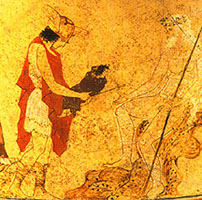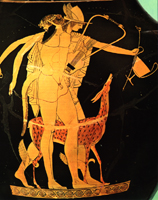Hermes (Roman Mercury)



Messenger of the gods and protector of travellers. Usually shown wearing short dress for travelling, often with a winged sunhat (petasos) and winged boots. He carries a kerykeion (Latin:
caduceus) - a wand which is commonly topped with a pair of entwined snakes. He is a mediator between gods, men, and the Underworld, and may be shown leading souls to
Hades. As a child he stole
Apollo's cattle, and in recompense invented the
lyre for the god. He kills
Argos who was watching Io for
Hera. He is a common companion for gods and in many scenes involving the interface between the mortal world and
Hades or
Olympos: conducting the
Judgement of Paris, leading the dead to
Charon at the Styx.
Above left: Hermes delivers the infant Dionysos. Detail from an Athenian white-ground clay vase, about 440 BC. Rome, Musei Vaticani 16586. © Musei Vaticani Licence Plate 11 UK 1007 156
Above middle: Marble statue. Zurich. Schweizerisches Landesmuseum P3447. Photo. Mus. P12529 © Schweizerisches Landesmuseum Licence Plate 11 UK 1007 157
Above right: Hermes and satyr. Detail from Athenian red-figure clay vase, about 525-475 BC. Berlin. Antikensammlung F2160 © Berlin. Antikensammlung.


